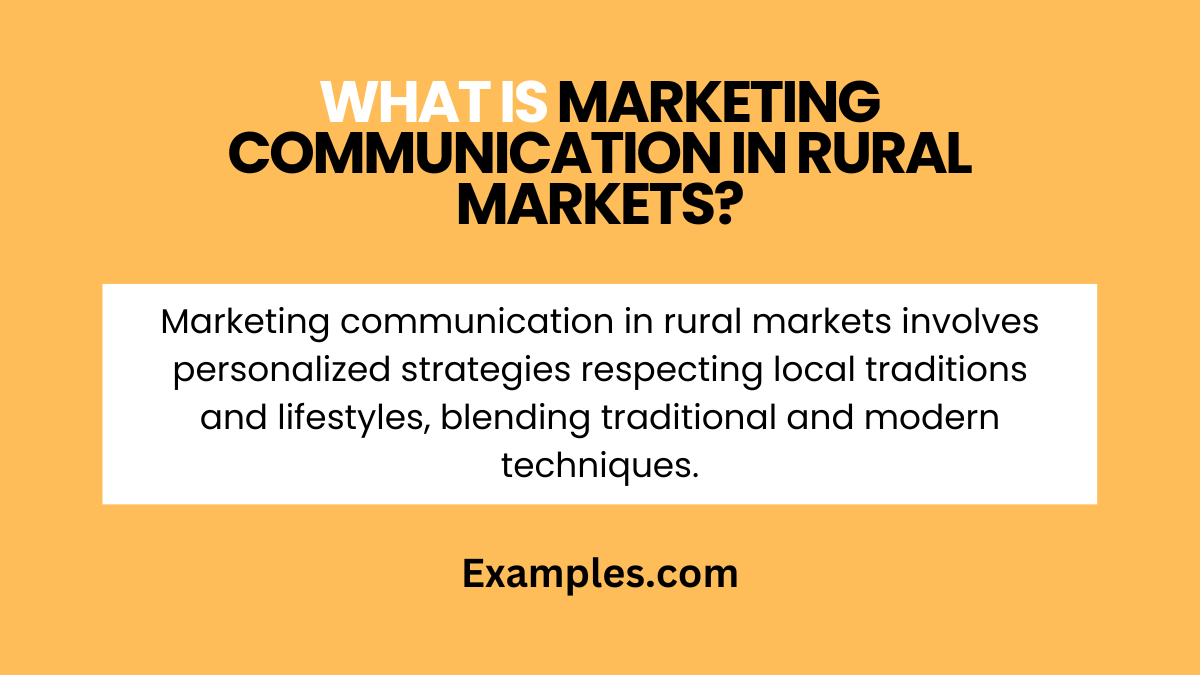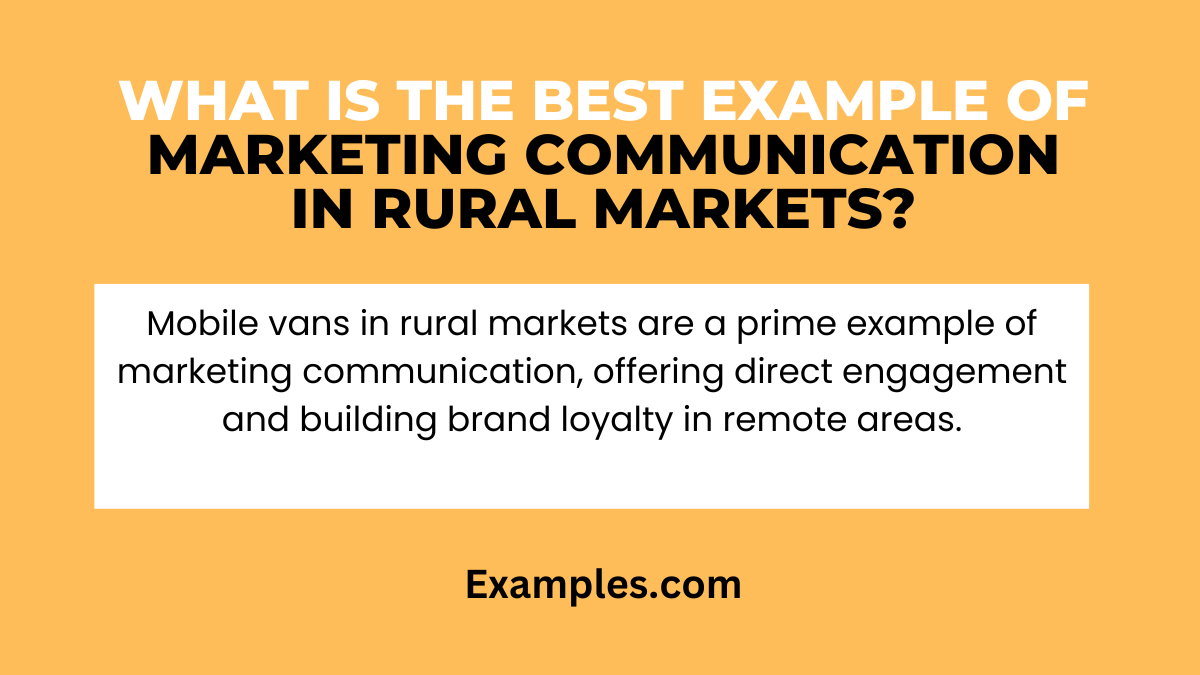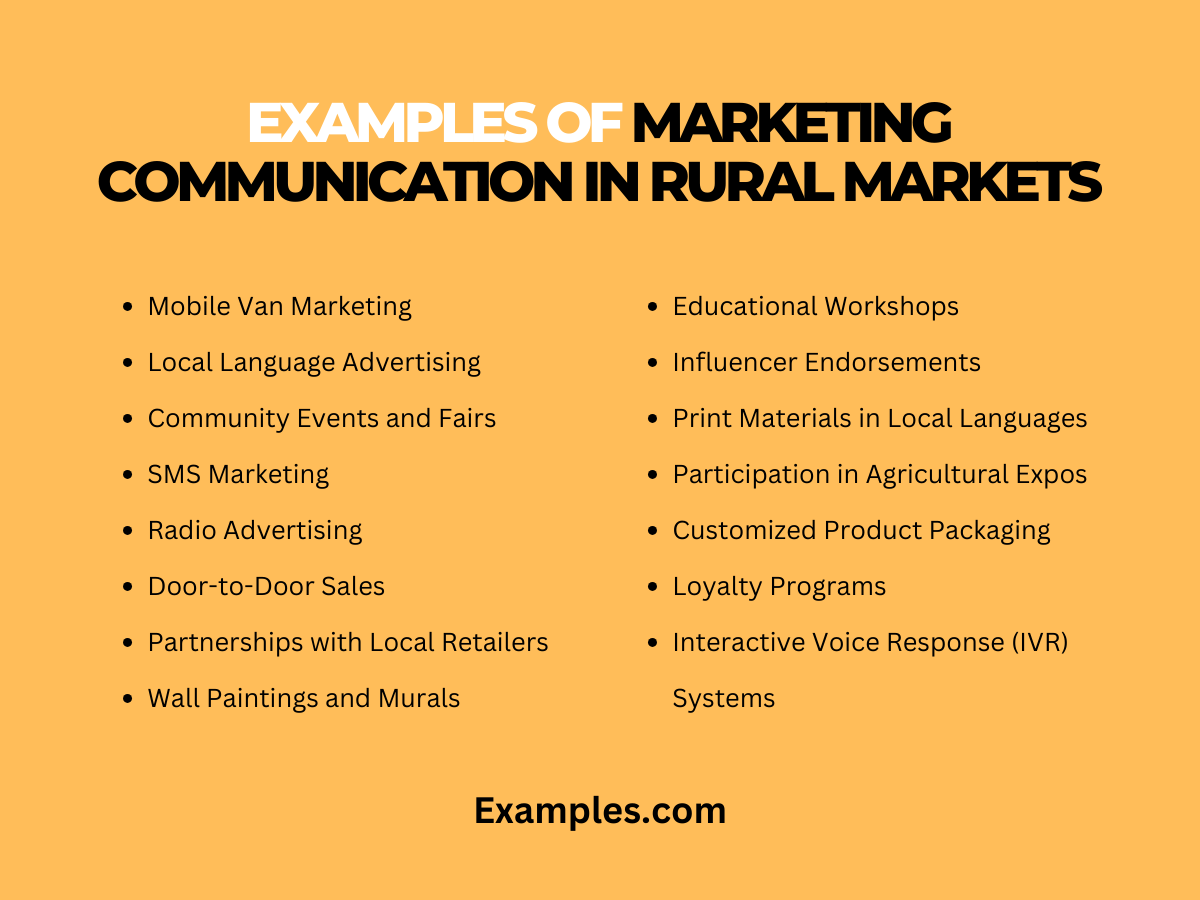Marketing Communication in Rural Markets
Embark on a journey through the unique landscape of Marketing Communication in Rural Markets with this detailed guide. In rural marketing, understanding the local culture, needs, and communication channels is crucial. This guide integrates internal communication strategies with external marketing tactics to effectively reach and engage rural audiences. Featuring a variety of real-world examples, it highlights how businesses can tailor their communication to resonate with rural communities, using both traditional and modern marketing techniques. From leveraging local influencers to utilizing mobile technology, these examples provide valuable insights for successfully navigating the diverse and often challenging rural market.
What is Marketing Communication in Rural Markets?

Marketing Communication in Rural Markets refers to the tailored strategies and methods used by businesses to reach and engage consumers in rural areas. Unlike urban markets, rural markets often require a more personalized approach, taking into consideration local languages, traditions, and communication preferences. Effective marketing in these areas involves a blend of traditional and modern communication techniques, understanding the unique lifestyle and consumption patterns of rural consumers.
What is the Best Example of Marketing Communication in Rural Markets?

A standout example of Marketing Communication in Rural Markets is the use of mobile vans for direct consumer engagement in remote areas. These mobile vans, equipped with product samples and a-visual aids, travel to various rural locations, providing product demonstrations and interactive experiences. This approach not only overcomes the challenge of limited access to traditional advertising media in these areas but also creates a direct and personal connection with rural consumers, leading to increased brand awareness and loyalty.
15 Examples of Marketing Communication in Rural Markets

Delve into the diverse world of Marketing Communication in Rural Markets with these 15 distinct examples. Each one illustrates how targeted communication strategies can effectively engage rural audiences, considering their unique preferences and challenges. From traditional methods like local events to digital innovations like SMS marketing, these examples demonstrate a range of tactics that businesses can employ to successfully connect with and appeal to rural consumers. This selection of examples highlights the importance of cultural sensitivity, personalization, and the creative use of both new and old communication channels in reaching and resonating with rural markets.
- Mobile Van Marketing: Using branded vans to conduct product demonstrations and distribute samples in remote areas.
- Example: “Our mobile marketing vans bring our products directly to rural consumers, allowing them to experience our brand firsthand.”
- Local Language Advertising: Tailoring advertisements to local languages and dialects for better connection and understanding.
- Example: “Our ads in the local dialect have significantly improved brand recall in rural areas.”
- Community Events and Fairs: Participating in or sponsoring local events to engage with the community and build brand presence.
- Example: “Sponsoring the annual harvest festival helped us build a strong rapport with the local community.”
- SMS Marketing: Leveraging text messaging to reach customers with limited internet access.
- Example: “Our SMS updates keep rural customers informed about new products and special offers.”
- Radio Advertising: Utilizing local radio stations to reach audiences in areas with limited TV or internet penetration.
- Example: “Radio jingles in regional languages have been effective in increasing our rural market penetration.”
- Door-to-Door Sales: Employing sales agents to personally visit homes and demonstrate products.
- Example: “Our door-to-door sales strategy has been instrumental in building trust with rural consumers.”
- Partnerships with Local Retailers: Collaborating with local shops and distributors to promote products.
- Example: “Partnering with local retailers has helped us gain shelf space and visibility in rural stores.”
- Wall Paintings and Murals: Creating eye-catching wall paintings in villages as a form of outdoor advertising.
- Example: “Our colorful wall murals in villages have become landmarks, constantly reminding locals of our brand.”
- Educational Workshops: Conducting workshops on topics relevant to the rural audience, integrating product information.
- Example: “Our agricultural workshops provide valuable information to farmers, while subtly introducing our agri-products.”
- Influencer Endorsements: Collaborating with local influencers who resonate with the rural populace.
- Example: “Endorsements from local community leaders have boosted our credibility in rural markets.”
- Print Materials in Local Languages: Distributing brochures, flyers, and catalogs in the local language.
- Example: “Our product catalogs in the regional language have been well-received in rural households.”
- Participation in Agricultural Expos: Showcasing products at expos and trade fairs frequented by rural audiences.
- Example: “Our presence at local agricultural expos has significantly increased our brand exposure among farmers.”
- Customized Product Packaging: Designing packaging that appeals to rural sensibilities and preferences.
- Example: “Our packaging, with local cultural motifs, has made our products more appealing in rural markets.”
- Loyalty Programs: Implementing loyalty and reward programs tailored to rural customers.
- Example: “Our loyalty program, with rewards suitable for rural lifestyles, has improved customer retention.”
- Interactive Voice Response (IVR) Systems: Using IVR for product information and customer support in local languages.
- Example: “Our IVR system in regional languages has made it easier for rural customers to access product information.”
Marketing Communication in Rural Markets for Business
Marketing Communication in Rural Markets for Business plays a crucial role in tapping into the potential of these often-overlooked markets. Businesses venturing into rural areas must adapt their communication strategies to suit the unique cultural, social, and economic landscape of these regions.
- Local Cultural Understanding: The key is to have an in-depth understanding of local cultures and customs. Using interpersonal communication and community engagement strategies can help businesses resonate better with rural audiences.
- Appropriate Channel Selection: Choosing the right communication channels is vital. While digital platforms are gaining ground, traditional media like local radio and print still hold significant sway in rural areas.
- Customized Messaging: Messages should be tailored to address the specific needs and lifestyles of rural consumers, utilizing effective communication techniques that are straightforward and relatable.
- Building Trust: Trust is a cornerstone in rural markets, often built through direct interaction and personal selling. Businesses should focus on establishing a strong, trustworthy presence.
- Community-Centric Approaches: Engaging with the community, sponsoring local events, or contributing to local causes can enhance brand image and acceptance.
Why is Marketing Communication Important for Rural Markets?
Marketing Communication is vital for rural markets due to the distinct characteristics and challenges these areas present.
- Overcoming Information Gaps: Many rural areas lack exposure to various products and services. Effective marketing communication helps bridge this information gap.
- Building Brand Awareness: In regions with limited brand exposure, marketing communication plays a key role in building brand recognition and loyalty.
- Cultural Relevance: It’s essential for messages to be culturally relevant and in sync with local norms, which can be achieved through tailored communication styles.
- Enhancing Accessibility: Clear communication can make products and services seem more accessible to rural consumers, who may otherwise feel disconnected from urban-centric brands.
- Education and Empowerment: Good marketing communication can educate rural consumers about product benefits, helping them make informed decisions.
What are the Key Components of Effective Marketing Communication in Rural Markets?
Effective Marketing Communication in Rural Markets involves several key components:
- Localized Content: Content should be localized, not just in language but also in context, resonating with the rural lifestyle and values.
- Personalization: Personalized communication, reflecting an understanding of rural consumers’ preferences and needs, can create more impactful engagement.
- Multi-Channel Strategy: A mix of traditional and modern channels, like community radio, local events, and mobile marketing, ensures wider reach.
- Feedback Mechanisms: Establishing channels for receiving feedback, such as customer helplines or community meetings, helps businesses understand and serve rural markets better.
- Consistent and Ongoing Engagement: Regular and consistent communication helps in building a long-term relationship with rural audiences.
What are the Challenges of Implementing Marketing Communication Strategies in Rural Markets?
Implementing Marketing Communication Strategies in Rural Markets comes with its own set of challenges:
- Diverse Audience Profiles: Rural markets are not homogeneous. Catering to diverse linguistic, cultural, and economic backgrounds requires nuanced and varied communication strategies.
- Limited Reach of Digital Platforms: Despite growing, the reach of digital platforms is still limited in many rural areas, necessitating a reliance on traditional communication methods.
- Logistical Barriers: Physical distribution and communication can be challenging due to poor infrastructure.
- Varied Consumer Behavior: Understanding and adapting to varied consumer behaviors and preferences in rural markets can be complex.
- Resource Constraints: Crafting and implementing effective marketing communication strategies in rural areas often requires additional resources and efforts, which can be a constraint for businesses.
In conclusion, this guide underscores the unique nuances of Marketing Communication in Rural Markets. It highlights the need for culturally relevant, personalized strategies and the effective use of diverse communication channels. Addressing these challenges and leveraging the key components discussed can lead to successful engagement in rural markets, opening new avenues for business growth and deeper consumer connections in these vital yet often underrepresented areas.



